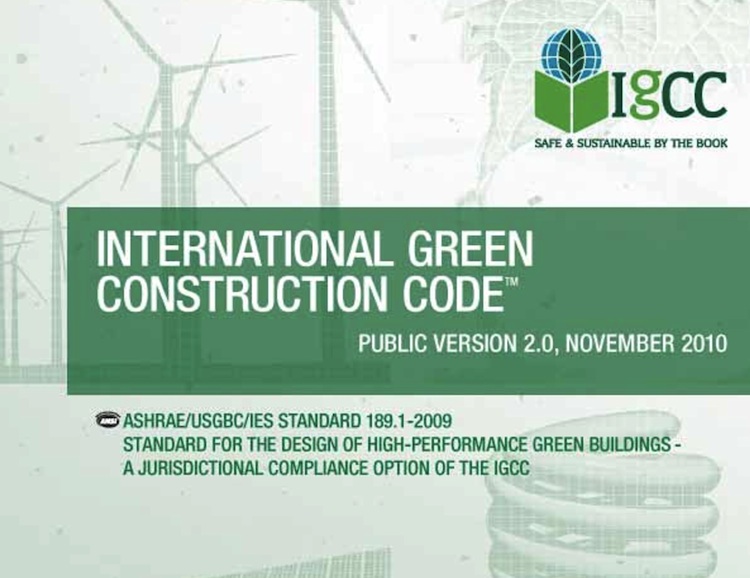Today’s post is by guest writer Anthony Floyd.
Anthony is a licensed architect and Senior Green Building/Energy Code Consultant for the City of Scottsdale. He previously served as building official for the City of Scottsdale from 1988 -1995. Anthony’s responsibilities in Scottsdale include education/outreach, energy performance evaluations and assessment of alternative building systems for building code compliance. He maintains Scottsdale’s regionally based green building program criteria, oversees implementation of the city adopted International Green Construction Code (IgCC) and works with the Public Works division in facilitating Scottsdale’s LEED Gold mandate for newly constructed and renovated city facilities. Anthony teaches building/energy code classes at ASU and a green building standards class at Scottsdale Community College. He is a certified ICC instructor and co-author of the recently published book – “Green Building: A Professional’s Guide to Concepts, Codes, and Innovation.” Anthony served on the Drafting and Public Hearing Committees for development of the International Green Construction Code (IGCC) and on the National Green Building Standard Consensus Committee in developing the ICC 700 National Green Building Standard. He currently chairs the Site Sustainability working group on the ASHRAE 189.1 Standards committee for the Design of High-Performance Green Buildings.
New energy codes and standards are projected to reduce energy use in new buildings by 30% as compared to 2004/2006 standards. The newly released International Green Construction Code (IgCC) goes further by not only reducing energy by 40%, but by setting minimum baselines for site development and land use, material selection, on-site renewable energy, water reuse, indoor pollutant control, acoustics and daylighting. The cities of Scottsdale and Phoenix are preparing to adopt and amend the 2012 IgCC by the end of this year. Other communities are expected to follow.
Green rating systems such as LEED are market-based programs for cutting-edge applications of sustainable design, whereas as the IgCC establishes minimum requirements for buildings. In other words, a green code creates a “floor” of minimum green building requirements, while green rating systems create a “ceiling” of higher green performance measures. LEED has optional credits for rating levels, while the IgCC has only a minimum baseline level without points or credits.
What does this mean for the construction industry and the green building community? What role will city building inspectors play in enforcement? How about third-party verification, commissioning and post-occupancy evaluation? Are there alternative paths and options for compliance with the green codes? The International Green Construction Code, ASHRAE 189.1 Standard for High Performance Green Buildings, National Green Building Standard, LEED and comparable green rating programs will be the focus of a new class (BLT 142) offered at Scottsdale Community College beginning Monday, August 20. The class will examine baseline criteria and regional applications for site development and land use, material resource conservation, energy efficiency and CO2 reduction, water resource conservation, indoor environmental quality, building commissioning, operations, and maintenance. The class course material will be based on a newly released book by Anthony Floyd (class instructor) and Allan Bilka (International Code Council) entitled, “Green Building: A Professional’s Guide to Concepts, Codes, and Innovation”. Below is an excerpt from the book preface.
Preface – Green Building: A Professional’s Guide to Concepts, Codes, and Innovation
Is green building ready for prime time? Is green building warranted in light of higher thresholds that have been set in current energy, mechanical, plumbing and building codes? Are green codes a natural progression of public health, safety and general welfare? Will green building codes and standards accelerate or hinder the principles behind green building and sustainable communities?
What about the obligations of design professionals, builders, developers, realtors, appraisers and financial institutions? How about the responsibilities of owners in the operation and maintenance of buildings? What about the level of responsibility of building regulatory authorities and their ability to enforce requirements after the certificate of occupancy is issued?
The answers to these questions and many others, including the coverage of provisions of the International Green Construction Code (IgCC), standards and rating systems, will unfold in the following pages. We will find that a fundamental understanding of design intent, rating tools, professional standards of care, contractual arrangements and construction codes and standards is required in order to answer these questions and fully comprehend their implications. In addition, all stakeholders, including the public and industry, must be willing to face reality, understand the dire potential consequences of ignoring our environmental responsibilities, and embrace change.
Beyond these questions, what is certain is that new opportunities for the design and building industry will be driven by outcome-based design, accountable construction, commissioning and the on-going operation of and demand for green buildings. New and expanded services will be needed for energy modeling, plan review, inspections, building commissioning, building performance monitoring and post-occupancy and outcome-based evaluations. Green building’s success, however, is dependent on an informed, capable and willing building industry. This book provides a wide array of valuable information that is intended to empower the building industry and enable it to move further down the path toward the critical goal of producing a sustainable built environment.
Click here for more information on the SCC class.
Photo credit: Image from docdtoc.

















